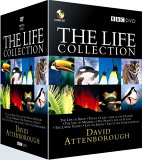 Attenborough - The Life Collection | DVD | (05/12/2005)
from £64.65
| Saving you £25.34 (39.20%)
| RRP
Attenborough - The Life Collection | DVD | (05/12/2005)
from £64.65
| Saving you £25.34 (39.20%)
| RRP Sir David Attenborough's epic series 'Life' spread out over 24 discs on this amazing box set. Includes: 1. Life On Earth 2. Trials Of Life 3. Life In The Freezer 4. Private Life Of Plants 5. Life Of Birds 6. Life Of Mammals 7. Life In The Undergrowth 8. The Living Planet For information regarding individual titles please refer to the individual products.
![Life in Cold Blood [DVD]](/pictures/1117155.jpg) Life in Cold Blood | DVD | (24/09/2012)
from £13.05
| Saving you £11.94 (91.49%)
| RRP
Life in Cold Blood | DVD | (24/09/2012)
from £13.05
| Saving you £11.94 (91.49%)
| RRP The last in David Attenborough's pioneering 'Life' series sees him exploring the fascinating lives of reptiles and amphibians that have roamed the planet for millions of years. Using the very latest in filming technology from the BBC's world-renowned Natural History Unit, David reveals the surprising and intimate lives of the cold-blooded reptiles and amphibians, discovering the secret of their success. From the largest and most dangerous reptiles on Earth demonstrating tender and sensual cou...
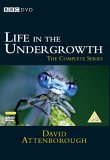 Life In The Undergrowth | DVD | (05/12/2005)
from £13.57
| Saving you £11.42 (84.16%)
| RRP
Life In The Undergrowth | DVD | (05/12/2005)
from £13.57
| Saving you £11.42 (84.16%)
| RRP David Attenborough reveals a secret universe - it is teeming with life and is all around us yet we never see it. It is the world of the very small and it is a world of sex drugs and violence. Here David shows us not just bugs beetles and creepy-crawlies but scorpions and centipedes mites and mantids spiders and dragonflies. And not just life in the undergrowth but the dramatic battles between predator and prey that are happening in the corner of your living room and in your la
![A Perfect Planet (Includes 5 Exclusive Art Cards) [Blu-ray] [2021]](/pictures/1154184.jpg) A Perfect Planet (Includes 5 Exclusive Art Cards) | Blu Ray | (01/02/2021)
from £17.98
| Saving you £N/A (N/A%)
| RRP
A Perfect Planet (Includes 5 Exclusive Art Cards) | Blu Ray | (01/02/2021)
from £17.98
| Saving you £N/A (N/A%)
| RRP Planet Earth is perfect. Everything about our world - its size, its distance from the Sun, its spin and tilt, its moon - is perfectly suited to our existence, and our planet's natural forces perfectly nurture life. A global weather system circulates and distributes fresh water to all corners of the globe, marine currents deliver nutrients to even the deepest reaches of the ocean, sunlight warms and energises everything it touches, and powerful volcanoes create and fertilise the land. As a result, there is literally no part of our planet where life can't be found. Episodes: Volcano The Sun Weather Oceans Humans Narrated by David Attenborough This product's case and sleeve are made from sustainable materials, without single use plastic: Card and paper are FSC certified Cases are made of recyclable Polypropylene (PP) containing 40% recycled plastic Inks are water based We have removed shrink wrap
![Kingdom of Plants - with David Attenborough [DVD]](/pictures/1116367.jpg) Kingdom of Plants - with David Attenborough | DVD | (20/07/2012)
from £5.95
| Saving you £14.04 (235.97%)
| RRP
Kingdom of Plants - with David Attenborough | DVD | (20/07/2012)
from £5.95
| Saving you £14.04 (235.97%)
| RRP Using beautifully shot footage to illustrate his own inimitable narrative style, David traces plants from their beginnings on land to their vital place in nature today, exposing new revelations along the way.
![David Attenborough's First Life [DVD]](/pictures/1103970.jpg) David Attenborough's First Life | DVD | (22/11/2010)
from £7.81
| Saving you £12.18 (155.95%)
| RRP
David Attenborough's First Life | DVD | (22/11/2010)
from £7.81
| Saving you £12.18 (155.95%)
| RRP The epic story of the beginning of life on Earth from the much loved and respected naturalist writer and broadcaster Sir David Attenborough. Spanning billions of years Attenborough's time-travelling narrative brings you face to face with the first animals that ever existed.
![Madagascar [Blu-ray]](/pictures/1105633.jpg) Madagascar | Blu Ray | (17/04/2019)
from £N/A
| Saving you £N/A (N/A%)
| RRP
Madagascar | Blu Ray | (17/04/2019)
from £N/A
| Saving you £N/A (N/A%)
| RRP DreamWorks Animation return with this adventure which centres on four animal friends, a lion, a giraffe, a hippo and a zebra.
![Private Life of Plants (Repackaged) [DVD]](/pictures/1118566.jpg) Private Life of Plants (Repackaged) | DVD | (24/09/2012)
from £10.30
| Saving you £9.69 (94.08%)
| RRP
Private Life of Plants (Repackaged) | DVD | (24/09/2012)
from £10.30
| Saving you £9.69 (94.08%)
| RRP David Attenborough's thrilling series, taking us on a guided tour through the secret world of plants, is captured on this amazing video. The account of plant life's struggle for survival is seen as never before in a story full of drama, beauty and staggering achievement. Attenborough takes us through each aspect of plants' lives travelling, growing, flowering, their struggle with other plants and animals, and the ingenious way they adapt to even the harshest of conditions. From the 290-foot-...
![David Attenborough Anthology - Complete Blu-Ray Collection [3D Blu-ray]](/pictures/1153475.jpg) David Attenborough Anthology - Complete Blu-Ray Collection | Blu Ray | (23/11/2020)
from £69.95
| Saving you £N/A (N/A%)
| RRP
David Attenborough Anthology - Complete Blu-Ray Collection | Blu Ray | (23/11/2020)
from £69.95
| Saving you £N/A (N/A%)
| RRP 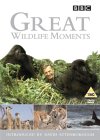 Great Wildlife Moments Introduced by David Attenborough | DVD | (17/11/2003)
from £4.90
| Saving you £11.09 (226.33%)
| RRP
Great Wildlife Moments Introduced by David Attenborough | DVD | (17/11/2003)
from £4.90
| Saving you £11.09 (226.33%)
| RRP Introduced and presented by David Attenborough, Great Wildlife Moments is a feature-length anthology that compiles some of the most memorable moments from the BBC Wildlife Unit. With a running time of 108 minutes it consists of 38 sequences drawn from the greatest archive of natural-history filmmaking in the world, breathtaking television spanning the entire biosphere from never-before-seen creatures in the ocean depths (Blue Planet, 2001) to Attenborough himself in zero gravity high above the Earth (The Living Planet, 1984). The anthology is divided into seven chapters covering different environments from "Snow and Ice" to "Jungles", an approach that both gives structure to the film and offers an effective vision of the sheer diversity of life on planet Earth. Most people's favourite sequences will be found here, from a killer whale taking a sea lion on the beach in The Trials of Life (1990) to Attenborough communing with mountain gorillas in Life on Earth (1979). Other segments come variously from BBC wildlife specials, Wildlife on One, The Natural World, The Kingdom of the Ice Bear (1985), Life in the Freezer (1993), The Private Life of Plants (1995), Attenborough in Paradise (1996), The Life of Birds (1998) and The Life of Mammals (2002), with additional narrators including John Hurt, Andrew Sachs and Simon King. This is a fine selection made all the more rewarding by Attenborough's endless enthusiasm and celebration of the world about us. On the DVD: Great Wildlife Moments is presented at 16:9, anamorphically enhanced for widescreen TVs. Unfortunately most of the material was originally shot for traditional 4:3 broadcast and so has been reformatted by carefully cropping shots at the top and/or bottom. For the most part this works acceptably with little of visual significance lost, though a sequence of emperor penguins from Life in the Freezer is ruined. Only one 4:3 segment--Attenborough high in the rainforest from Attenborough in Paradise--has been presented in its original ratio. Picture quality varies depending on the age of the clips, with material from Blue Planet and The Life of Mammals being flawless and older footage offering some grain, which is never too distracting. Sound is again variable, the Dolby Prologic soundtrack effectively smoothing the transitions between older mono soundtracks and more recent surround sound. The main extra is a fine commentary that is specific to each sequence and calls on the original producers, directors or cameramen (most but not every section has a commentary), while a 12-minute "making of" is actually more of an extended trailer for other BBC wildlife DVDs. The disc also includes a useful BBC Natural History Unit filmography. --Gary S Dalkin
![The Private Life of Plants [1994]](/pictures/1032244.jpg) The Private Life of Plants | DVD | (01/09/2003)
from £7.12
| Saving you £12.87 (180.76%)
| RRP
The Private Life of Plants | DVD | (01/09/2003)
from £7.12
| Saving you £12.87 (180.76%)
| RRP David Attenborough's thrilling series taking us on a guided tour through the secret world of plants is captured on this amazing video. The account of plant life's struggle for survival is seen as never before in a story full of drama beauty and staggering achievement. Attenborough takes us through each aspect of plants' lives travelling growing flowering their struggle with other plants and animals and the ingenious way they adapt to even the harshest of conditions. From the
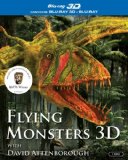 Flying Monsters (Blu-ray 3D) | Blu Ray | (07/11/2011)
from £15.95
| Saving you £4.04 (25.33%)
| RRP
Flying Monsters (Blu-ray 3D) | Blu Ray | (07/11/2011)
from £15.95
| Saving you £4.04 (25.33%)
| RRP 220 million years ago, as dinosaurs were beginning their domination of Earth, another group of reptiles was about to make an extraordinary leap. Pterosaurs were taking control of the skies. The story of how and why these mysterious creatures took to the air is more fantastical than any fiction. In Flying Monsters, Sir David Attenborough sets out to uncover the truth about the enigmatic pterosaurs whose wingspans of up to 40 feet were equal to that of a modern day jet plane. The central question and of the greatest mysteries in palaeontology is how and why did pterosaurs fly. How did creatures the size of giraffes defy gravity and soar through prehistoric skies? Attenborough starts to unravel one of science’s more enduring mysteries, discovering that the marvel of pterosaur flight has evolutionary echoes that resonate even today.
![David Attenborough's Natural Curiosities - Series 3 [DVD]](/pictures/1140102.jpg) David Attenborough's Natural Curiosities - Series 3 | DVD | (06/06/2016)
from £9.69
| Saving you £10.30 (106.30%)
| RRP
David Attenborough's Natural Curiosities - Series 3 | DVD | (06/06/2016)
from £9.69
| Saving you £10.30 (106.30%)
| RRP All six episodes from the third series of the documentary presented by esteemed British naturalist David Attenborough exploring some of the natural world's greatest curiosities. Among the issues examined by Attenborough are IQ research on orangutans and crows, the eating methods of large constrictor snakes and the powers of regeneration. The episodes are: 'Impossible Feats', 'Curious Minds', 'Expandable Bodies', 'Curious Feeders', 'Curious Cures' and 'Remarkable Regeneration'.
![David Attenborough's Life Of Birds [1998]](/pictures/1032812.jpg) David Attenborough's Life Of Birds | DVD | (04/12/2000)
from £18.66
| Saving you £11.33 (60.72%)
| RRP
David Attenborough's Life Of Birds | DVD | (04/12/2000)
from £18.66
| Saving you £11.33 (60.72%)
| RRP Like the albatross glimpsed in the beginning of this 10-part series The Life of Birds quickly takes flight. Sir David Attenborough hosts this unprecedented and extraordinary global look at the magnificent and often curious winged species with which we share our planet. Like the best wildlife shows, The Life of Birds offers a fresh and accessible view of creatures we may take for granted (didn't Alfred Hitchcock warn us about that?). The focus of this series is not on the different bird species, but on bird behaviour. Remarkable and awe-inspiring footage preserves the wide range of tools and techniques with which birds fly, hunt for food, attract a mate, hatch their chicks and defend themselves against predators. Attenborough pops up in the most remote, most exotic locales, with occasional comic effect: at one point, night-vision cameras capture the rare sight of the nocturnal kiwi as it forages for food on a New Zealand beach; the camera pans to reveal scant paces away our guide shining a flashlight on the nonplussed bird. --Donald Liebenson
![Madagascar [DVD]](/pictures/1105622.jpg) Madagascar | DVD | (07/03/2011)
from £8.42
| Saving you £11.57 (137.41%)
| RRP
Madagascar | DVD | (07/03/2011)
from £8.42
| Saving you £11.57 (137.41%)
| RRP DreamWorks Animation return with this adventure which centres on four animal friends, a lion, a giraffe, a hippo and a zebra.
![Charles Darwin and the Tree of Life (Repackaged) [DVD]](/pictures/1118570.jpg) Charles Darwin and the Tree of Life (Repackaged) | DVD | (24/09/2012)
from £12.84
| Saving you £7.15 (55.69%)
| RRP
Charles Darwin and the Tree of Life (Repackaged) | DVD | (24/09/2012)
from £12.84
| Saving you £7.15 (55.69%)
| RRP 'Nothing in the natural world makes sense - except when seen in the light of evolution.' David Attenborough A personal insight from the world's favourite naturalist into Darwin's theory of evolution. This special documentary was made to celebrate the 200th anniversary of the birth of Charles Darwin and the 150th anniversary of the publication of 'On The Origin Of Species'. Darwin's great insight - that life has evolved over millions of years by natural selection - has been the corne...
![David Attenborough's Rise of Animals: Triumph of the Vertebrates ( As Seen On BBC ) [DVD]](/pictures/1124774.jpg) David Attenborough's Rise of Animals: Triumph of the Vertebrates ( As Seen On BBC ) | DVD | (28/10/2013)
from £12.98
| Saving you £8.00 (80.08%)
| RRP
David Attenborough's Rise of Animals: Triumph of the Vertebrates ( As Seen On BBC ) | DVD | (28/10/2013)
from £12.98
| Saving you £8.00 (80.08%)
| RRP Take a 500 million-year journey back through time and discover the epic story of the vertebrates. David Attenborough has spent his career marvelling at the beauty and variety of animal life on Earth constantly in awe of the incredible diversity of creatures that have evolved from just a handful of ancient life forms. Now with newly discovered fossil sites and advances in scientific research David can piece together biological clues from animals alive today to make the extraordinary connections that explain how the incredible range of creatures on Earth came to be. On an eye-opening journey that combines captivating CGI graphics with groundbreaking natural history footage David also reveals some fascinating truths about our own human biology and uncovers some of the amazing ways that our bodies today still bare the traces of this epic evolutionary story.
![Trials of Life [Blu-ray]](/pictures/1117788.jpg) Trials of Life | Blu Ray | (12/11/2012)
from £16.49
| Saving you £6.50 (39.42%)
| RRP
Trials of Life | Blu Ray | (12/11/2012)
from £16.49
| Saving you £6.50 (39.42%)
| RRP David Attenborough's remarkable 1990 landmark series has been re-mastered for this release sharper and clearer than it has ever been seen before. Examining animal behaviour from birth to adulthood, twelve 50-minute episodes each feature a different aspect of the journey through life, from finding food and hunting to making homes and protecting the next generation. The series remains a TV classic, renowned for its many incredible wildlife sequences including killer whales beaching themselves to catch sea lions, chimpanzees undertaking a brutal hunt for colobus monkeys, footage from the inside of an army ant bivouac and the amazing surge to the sea of millions of red crabs in Christmas Island.
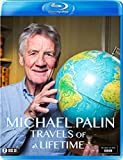 Michael Palin: Travels of a Lifetime Blu-Ray | Blu Ray | (05/04/2021)
from £9.69
| Saving you £N/A (N/A%)
| RRP
Michael Palin: Travels of a Lifetime Blu-Ray | Blu Ray | (05/04/2021)
from £9.69
| Saving you £N/A (N/A%)
| RRP This series sees the much-loved TV traveller revisit four of his famous documentary series Around the World in 80 Days, Pole to Pole, Full Circle and Sahara. Also includes the Christmas special. In intimate conversation, and using his personal archive, he reflects on how he got addicted to travel, and reveals the challenges he faced making these ground-breaking series. In addition, famous fans including Simon Reeve and Joanna Lumley explain how Michael inspired them to go on adventures of their own.
![Galapagos with David Attenborough ( As Seen On Sky ) [DVD]](/pictures/1124783.jpg) Galapagos with David Attenborough ( As Seen On Sky ) | DVD | (18/11/2013)
from £12.63
| Saving you £7.36 (58.27%)
| RRP
Galapagos with David Attenborough ( As Seen On Sky ) | DVD | (18/11/2013)
from £12.63
| Saving you £7.36 (58.27%)
| RRP One of the most beautiful and complex 3D projects ever filmed. 'Galapagos is one of the wonder places of the world a laboratory of evolution. Because of Darwin it is always a historic place for any zoologist. Anyone interested in the history of life on Earth and how it came to be really has to come here.' - David Attenborough. In this stunning series David Attenborough peels back the Earth's surface to shed light on the hidden forces that have built and shaped one of its most amazing places: the islands of the Galapagos. This landmark three-part documentary introduces us to a range of extraordinary creatures - from the iconic Giant Tortoise to the courting Waved Albatrosses - while the use of 3D technology allows us to see all this as if we are actually there. The result is a truly mesmerising exploration of the world's most miraculous landscape plant life and animals.

Please wait. Loading...
This site uses cookies.
More details in our privacy policy